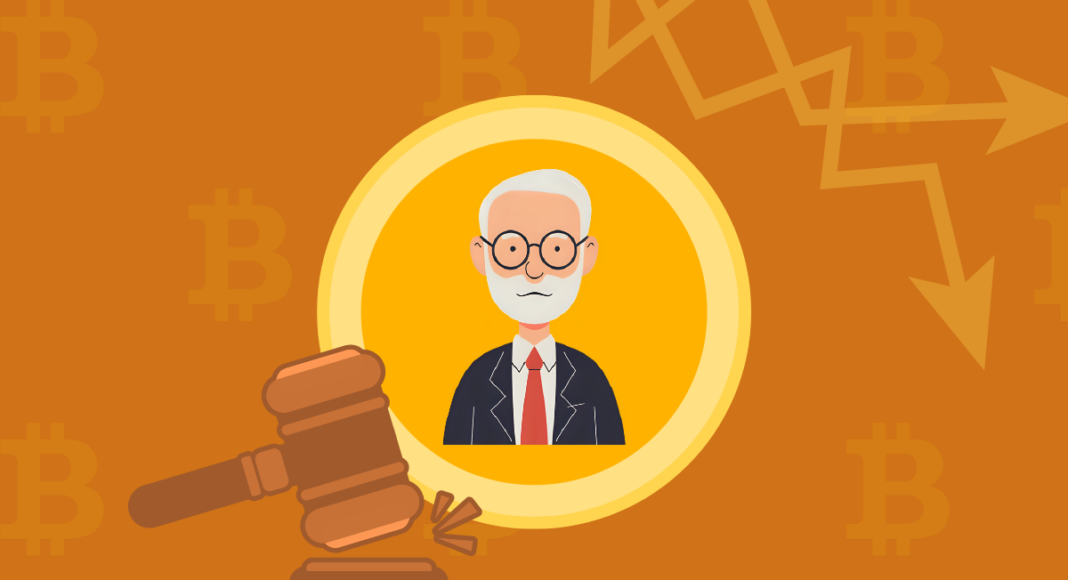Judge Jed S. Rakoff of the United States District Court for the Southern District of New York reflects on the history of cryptocurrency and his experience adjudicating criminal cases involving it.
ProMarket is publishing a series of articles in collaboration with Stanford University’s Program on Capitalism and Democracy. These articles are based on the conversations that occurred during the Program’s 2025 Global Capitalism, Trust, and Accountability Conference. You can visit their website for additional content.
In her very prescient 2024 book, The Tech Coup: How To Save Democracy From Silicon Valley, Marietje Schaake, the international policy director at Stanford University’s Cyber Policy Center, states that “perhaps the most avid users of cryptocurrencies have been a group that explicitly values their opaque nature: criminals.” Based on the cryptocurrency cases that have come before me and my colleagues in recent years, this statement seems well supported. And even though President Donald Trump, who once described Bitcoin as likely a “scam,” has now embraced cryptocurrency with a passion, the overpromoted and underregulated nature of current cryptocurrency transactions strongly suggests that more cryptocurrency scams are in the offing. In this article, I reflect on my experience with cryptocurrency and explain why its nature as a conduit for crime will likely continue for the foreseeable future.
A brief history of cryptocurrency and crime
The idea for a digital currency that can be used to buy and sell online products and services goes back at least to the early 1980s. However, it was the advent of Bitcoin in 2009 that really got things going. Bitcoin and its successors promised not just convenience and savings but also freedom from government oversight. Indeed, from nearly the very outset, cryptocurrency gloried in the fact that it was unregulated, or, as its proponents claimed, self-regulating. If this sounds like a familiar pitch, it should, as it is a variation on the position taken by many defenders of unregulated capitalism before the Great Depression.
Of course, if cryptocurrency had actually succeeded in becoming a widely used and accepted form of actual currency in the United States, its effects on both the U.S. banking system and the Federal Reserve’s monetary policy would have been devastating. But it has never really taken off in the manner intended. Only one small nation, El Salvador, has adopted a form of cryptocurrency as its national currency. But a much bigger nation, China, has banned cryptocurrency altogether. In the U.S. and most other places, most people still make most of their purchases and sales in dollars or other regulated national currencies. Yet, cryptocurrency’s hucksters remain undeterred.
For from the start, and still now, cryptocurrency has been promoted as the wave of the future, with the accompanying suggestion that if you are a smart investor, you would purchase your cryptocurrency now, before its price “inevitably” rises. Cryptocurrency has been, and still is, primarily marketed as a speculative investment. However there are two key differences from other speculative investments: first, what you are investing in with cryptocurrency is not some underlying product, but simply the hope that some day cryptocurrency will become a widespread form of actual currency. Second, what you are investing in, or gambling on, is something that is largely hidden and opaque in its operations—hence the word “crypto”—and also largely free of government regulation and proud of it. To say that these differences make cryptocurrency attractive to crooks is to state the obvious.
Perhaps the earliest criminal use of cryptocurrency was to launder money. A drug lord, for example, could use his ill-gotten proceeds to purchase cryptocurrency, secure in the knowledge that the market was unregulated and the transactions easily concealed under phony names and secret accounts. He could then sell his cryptocurrency at the other end to cryptocurrency purchasers and wind up with lots of cash or other forms of remuneration not easily traced to the underlying narcotics sales.
Based on this model, a man named Ross Ulbricht developed a black market cryptocurrency exchange called the “Silk Road” that facilitated this and other forms of money-laundering by drug lords throughout the world. But in 2013 he was caught and tried before one of my fellow judges, Katherine Forrest, who, because of the huge size of Ulbricht’s criminal enterprise, sentenced Ulbricht in 2015 to life imprisonment. This past January, Trump gave Ulbricht a full pardon.
What I’ve learned from adjudicating cryptocurrency cases
The Silk Road provided my first encounter with how cryptocurrency could facilitate money laundering. In 2014, I presided over a criminal case involving two men who knowingly aided money-laundering on the Silk Road. Both defendants pled guilty. I vividly remember how one of the defendants, Charlie Shrem, stated at his sentencing that he still believed Bitcoin to be the wave of the future. After he completed his two years in prison, Shrem became a leading advocate for cryptocurrency.
Unexpectedly, I saw Shrem in my courtroom a few years later when he was sued by the Winklevoss twins, who alleged he had cheated them out of millions of dollars in a Bitcoin investment. The case was eventually settled, but what I most remember was seeing Shrem sitting in my courtroom wearing a very expensive suit. So I guess not everyone who invests in cryptocurrency loses his shirt!
As the cryptocurrency market continues to rise and fall, often with lightning speed, new forms of cryptocurrency have quickly developed. These include so-called “altcoins,” that is, direct competitors to Bitcoins. Another, perhaps more comical form of cryptocurrency tokens are so-called “memecoins,” that is, crypto assets named after some public figure or fad. I suppose I should be flattered that about a year ago, two gentlemen came out with a new memecoin named “$Rakoff,” complete with a cartoon likeness of this author, which they marketed aggressively until I got wind of it and demanded they remove my name. But you can still purchase their crypto token under its new name, “$Jurist,” which now features a cartoon likeness of a generic judge, complete with a wig. Or, if you prefer, you can purchase the memecoin that Trump launched shortly before his inauguration, known as “$Trump.” After an initial surge, the price of $Trump fell dramatically. But who knows what tomorrow may bring, and the entire Trump family is now promoting various forms of cryptocurrency under the name “Official Trump.”
Less comically, memecoins have proven highly volatile, and investors in many of them have lost billions of dollars. Trade in memecoins frequently involves variations on what used to be called a “pump and dump” scheme but is now called, in crypto-jargon, a “rug pull.” In these schemes, the promoters of memecoins hype their latest offering, causing the price to rise, and then secretly sell off their personal holdings before the price inevitably crashes. But this familiar form of fraud did not stop Trump’s newly appointed heads of the Securities Exchange Commission from recently advising their staff that transactions in memecoins usually do not constitute, in their view, transactions subject to the federal securities laws.
Still another form of digital assets, the legal status of which remains uncertain, are so-called “stablecoins,” which are cryptocurrency tokens purportedly designed to maintain a stable value and thus counter the volatility that has made cryptocurrency investments so much a gamble. However, many of these stablecoins have, as often as not, devolved into fraud.
A good example is a case that came before me less than two years ago, entitled S.E.C. v. Terraform, Inc. Terraform was founded by a South Korean named Do Kwon and offered various kinds of cryptocurrency tokens to investors under names like “Terra” and “Luna.” According to Terraform, the tokens were all subject to a very sophisticated (but secret) algorithmic trading mechanism developed by Do Kwon that would guarantee that their market value, purchased at a price of $1 per token, would never fall below $1 for less than a few minutes. In other words, a purchaser could never lose money. Even in Cryptoland, this was initially greeted with some skepticism.
However, when early on the price of a Terraform token, having fallen one morning to 90 cents, immediately rebounded to above $1, investors began to believe the hype, and the price of Terraform tokens skyrocketed. This great increase in value was also aided by Terraform’s subsequent announcement that it had convinced a South Korean mobile payment application, similar to Zelle but called Choi, to allow the Terraform blockchain to process and settle consumer transactions.
The SEC alleged that this was all a pack of lies. Specifically, the only reason the Terraform token price had immediately rebounded after falling to 90 cents was that Do Kwon had secretly arranged for a confederate to make a huge but secret investment in the tokens, causing the price to rebound.
Similarly, Choi never actually used the Terraform blockchain to process its actual transactions, but simply allowed Terraform to pretend this was happening by allowing Terraform to create fake blockchain records that simply mimicked the non-Terraform payments being handled by Choi.
After the SEC brought the suit, the price of Terraform’s tokens fell to as low as 11 cents per token and investors lost something above $40 billion. The SEC’s complaint was assigned to me, but Terraform immediately moved to dismiss on the ground that the investors who bought the tokens were not investing in securities subject to SEC jurisdiction. I eventually held that the tokens were in fact disguised securities, but even then not every court agreed that this was true of many cryptocurrency investments. The issue remains unresolved to this day, not least because the S.E.C.’s new leadership has greatly cut back on enforcement proceedings involving cryptocurrency.
Before this happened, however, the Terraform case before me was tried before a jury, which found Terraform liable on all counts, involving, as mentioned, a loss to investors of over $40 billion. The SEC settled the case with Terraform for a fraction of this amount, prompted perhaps by the fact that the company had by then gone into bankruptcy.
Cryptocurrency criminality is very much a global problem. The Silk Road, already discussed, is an early example. In February 2014, the global bitcoin exchange known as “Mt. Gox” declared bankruptcy, confessing that it had somehow “lost” 750,000 bitcoins (7 percent of all the bitcoins then in existence worldwide). Because of its dependence on digital entries unpoliced by banking institutions, cryptocurrency is particularly prone to theft by hackers, with losses of billions of dollars reported throughout the world. And to give still another example, cryptocurrency is the form that perpetrators of ransomware schemes usually demand that the ransom be paid, so as to further conceal their identities.
In any case, two lessons can perhaps be gleaned from just the Terraform case alone. The first is how easily investors are misled when it comes to something as superficially attractive, and yet arcane, as cryptocurrency. The second is how little regulation of this market there actually is. Just this past April, for example, the SEC dismissed three of its largest pending enforcement actions against cryptocurrency ventures, stating this was part of the SEC’s reassessment of its approach to crypto regulation.In addition to the SEC’s new stance, bank regulators like the Office of the Comptroller of the Currency, who might well claim to have jurisdiction over anything called cryptocurrency, have recently scaled back, if not eliminated altogether, the modest supervision they had previously exercised over this market. And while Congress has now passed legislation designed to make some of the cryptocurrency markets more stable, much less has been done to address fraud in these markets.
In sum, this much seems clear. First, the cryptocurrency market is awash in hifalutin promotions, when in fact its actual success in developing an alternative to conventional currencies is very, very modest. Second, the cryptocurrency market remains largely unregulated, and seems likely to remain so for at least the immediate future, thus making it an attractive venue for fraud, money laundering, and other criminal activity. And third, the result is that investors have already been deceived into investments that have cost them tens of billions of dollars in losses, which is likely to continue. This, one might venture to conclude, is not a happy situation.
Author Disclosure: The author reports no conflicts of interest. You can read our disclosure policy here.
Articles represent the opinions of their writers, not necessarily those of the University of Chicago, the Booth School of Business, or its faculty.
Subscribe here for ProMarket’s weekly newsletter, Special Interest, to stay up to date on ProMarket’s coverage of the political economy and other content from the Stigler Center.






